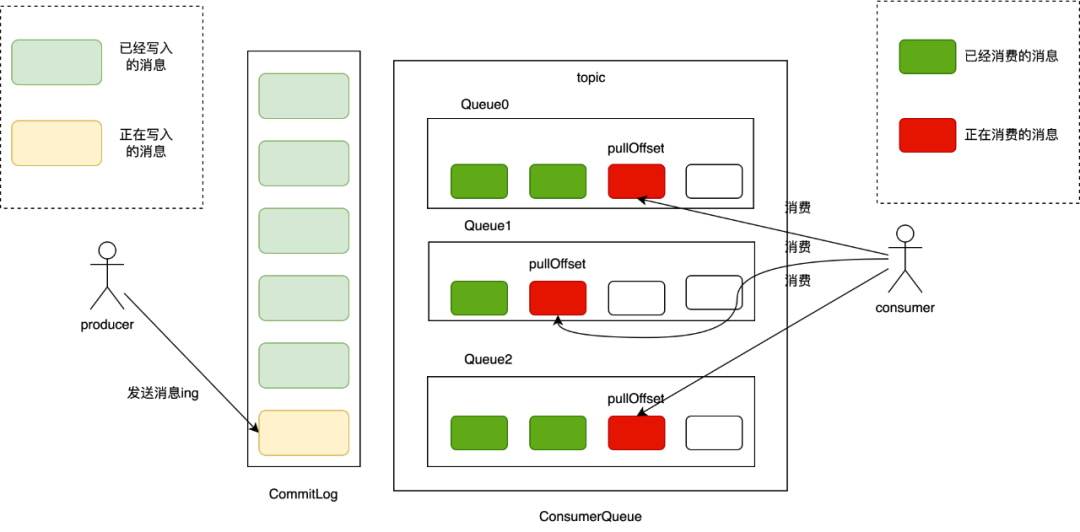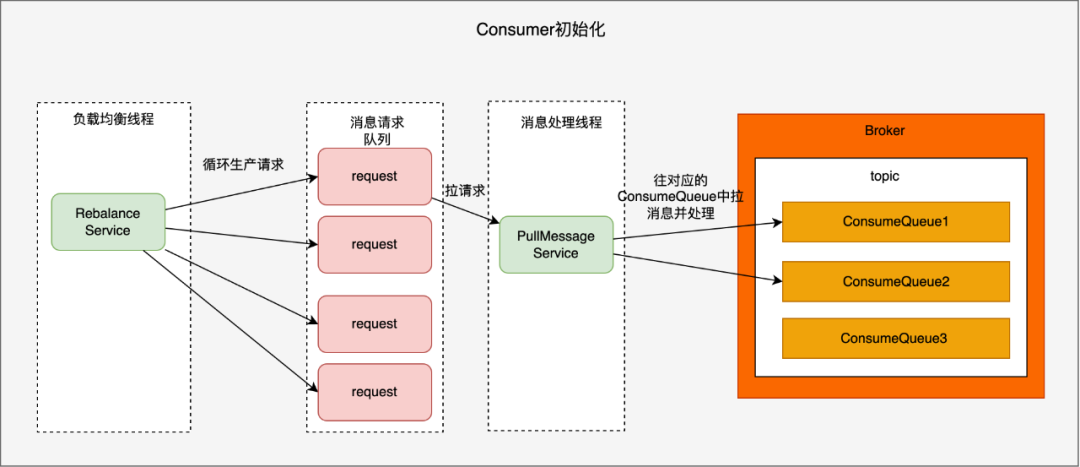
探索RocketMq消息中间件的奥秘:深入源码剖析消费者消费流程与存储架构。本文从RocketMq消息存储的精细设计出发,揭秘CommitLog与ConsumerQueue如何携手实现高效存储与快速消费,旨在为读者搭建起通往RocketMq核心原理的桥梁,激发进一步探索的兴趣。

我的疑问
在看源码之前,我对RocketMq中间件的实现方式有以下几个疑问:
消息的存储架构是如何的?
消费者是怎么拉取消息的?
RocketMq是怎么做负载均衡策略的?
源码学习▐ RocketMq存储架构

RocketMq存储架构中的实现通过两个核心的文件,分别是CommitLog文件和ConsumerQueue文件。CommitLog存储消息主体,消费者发送的消息会顺序的写入到CommitLog文件中,通过顺序写保障了写入的效率。
为了提高消费者消费消息的速度,引入了ConsumerQueue文件,文件位置位于$HOME/store/consumequeue/{topic}/{queueId}/{fileName},每条记录的内容是8字节的CommitLog偏移量,4字节的消息长度以及8字节的Tag hashcode。通过ConsumerQueue,就能在保障写入效率的同时同时提高消费速度,起到了索引的作用。
▐ 消费者如何消费消息
消费者消费流程示意图

上图是消费者消费流程的示意图,核心是负载均衡模块和消息处理模块。
负载均衡线程会跑一个while循环,轮询当前客户端所有订阅的topic,根据topic进行负载均衡,通过负载均衡定位到要消费的队列以及消费偏移量,存放到pullRequstQueue中。若订阅了同一个topic的消费者没有变化(新加入或退出),负载均衡线程不会放入新的请求到pullRequstQueue中,只有当订阅者出现变化的时候,才会放入新的请求到队列。
消息处理线程也会跑一个while循环,不断的从pullRequstQueue中取拉消息请求,之后向Broker获取到指定队列指定偏移量的消息体,获取到消息后触发回调对消息进行消费。
具体实现
负载均衡线程(RebalanceService)初始化
在消费者(DefaultMQPushConsumerImpl)初始化的过程中,会创建一个单例的MQClientInstance对象,然后调用该类的start方法进行初始化。
public void start() throws MQClientException {
synchronized (this) {
switch (this.serviceState) {
case CREATE_JUST:
this.serviceState = ServiceState.START_FAILED;
// If not specified,looking address from name server
if (null == this.clientConfig.getNamesrvAddr()) {
this.mQClientAPIImpl.fetchNameServerAddr();
}
// Start request-response channel
this.mQClientAPIImpl.start();
// Start various schedule tasks
this.startScheduledTask();
// Start pull service
this.pullMessageService.start();
// Start rebalance service
this.rebalanceService.start();
// Start push service
this.defaultMQProducer.getDefaultMQProducerImpl().start(false);
log.info("the client factory [{}] start OK", this.clientId);
this.serviceState = ServiceState.RUNNING;
break;在start方法中,会开启一个负载均衡线程(this.rebalanceService.start())和一个消息处理线程(pullMessageService.start())。
负载均衡线程启动后,会跑一个while循环,每隔一段时间触发负载均衡策略, 更新消费队列。
public void run() {
log.info(this.getServiceName() + " service started");
while (!this.isStopped()) {
this.waitForRunning(waitInterval);
this.mqClientFactory.doRebalance();
}
log.info(this.getServiceName() + " service end");
}从mqClientFactory.doRebalance()方法进入到org.apache.rocketmq.client.impl.factory.MQClientInstance#doRebalance方法。
在该方法中,首先轮询获取当前客户端注册到本地的所有Consumer实例,对每个Consumer实例,调用doRebalance方法进行负载均衡处理。
public void doRebalance() {
for (Map.Entry<String, MQConsumerInner> entry : this.consumerTable.entrySet()) {
MQConsumerInner impl = entry.getValue();
if (impl != null) {
try {
impl.doRebalance();
} catch (Throwable e) {
log.error("doRebalance exception", e);
}
}
}
}从impl.doRebalance()进入到
org.apache.rocketmq.client.impl.consumer.RebalanceImpl#doRebalance方法。
在该方法内部,首先会轮询获取到所有的订阅信息,针对每个订阅的topic,进行负载均衡处理。
public void doRebalance(final boolean isOrder) {
Map<String, SubscriptionData> subTable = this.getSubscriptionInner();
if (subTable != null) {
for (final Map.Entry<String, SubscriptionData> entry : subTable.entrySet()) {
final String topic = entry.getKey();
try {
this.rebalanceByTopic(topic, isOrder);
} catch (Throwable e) {
if (!topic.startsWith(MixAll.RETRY_GROUP_TOPIC_PREFIX)) {
log.warn("rebalanceByTopic Exception", e);
}
}
}
}从this.rebalanceByTopic(topic, isOrder)方法进入到
org.apache.rocketmq.client.impl.consumer.RebalanceImpl#rebalanceByTopic()
在该方法内部,会获取到当前topic下的所有的队列集合(mqAll)和当前topic当前消费者组的消费者ID集合(cidAll)。
调用方法:
allocateResult = strategy.allocate
(this.consumerGroup,this.mQClientFactory.getClientId(),mqAll,cidAll);
strategy.allocate方法内部会调用allocateAveragely这个负载均衡策略,确定该消费者实例要消费的队列。
private void rebalanceByTopic(final String topic, final boolean isOrder) {
switch (messageModel) {
case CLUSTERING: {
Set<MessageQueue> mqSet = this.topicSubscribeInfoTable.get(topic);
List<String> cidAll = this.mQClientFactory.findConsumerIdList(topic, consumerGroup);
if (null == mqSet) {
if (!topic.startsWith(MixAll.RETRY_GROUP_TOPIC_PREFIX)) {
log.warn("doRebalance, {}, but the topic[{}] not exist.", consumerGroup, topic);
}
}
if (null == cidAll) {
log.warn("doRebalance, {} {}, get consumer id list failed", consumerGroup, topic);
}
if (mqSet != null && cidAll != null) {
List<MessageQueue> mqAll = new ArrayList<MessageQueue>();
mqAll.addAll(mqSet);
Collections.sort(mqAll);
Collections.sort(cidAll);
AllocateMessageQueueStrategy strategy = this.allocateMessageQueueStrategy;
List<MessageQueue> allocateResult = null;
try {
allocateResult = strategy.allocate(
this.consumerGroup,
this.mQClientFactory.getClientId(),
mqAll,
cidAll);
} catch (Throwable e) {
log.error("AllocateMessageQueueStrategy.allocate Exception. allocateMessageQueueStrategyName={}", strategy.getName(),
e);
return;
}
Set<MessageQueue> allocateResultSet = new HashSet<MessageQueue>();
if (allocateResult != null) {
allocateResultSet.addAll(allocateResult);
}
boolean changed = this.updateProcessQueueTableInRebalance(topic, allocateResultSet, isOrder);
if (changed) {
log.info(
"rebalanced result changed. allocateMessageQueueStrategyName={}, group={}, topic={}, clientId={}, mqAllSize={}, cidAllSize={}, rebalanceResultSize={}, rebalanceResultSet={}",
strategy.getName(), consumerGroup, topic, this.mQClientFactory.getClientId(), mqSet.size(), cidAll.size(),
allocateResultSet.size(), allocateResultSet);
this.messageQueueChanged(topic, mqSet, allocateResultSet);
}
}
break;
}
default:
break;
}
}默认是allocateAveragely这个平均分配负载均衡策略,举个例子:
当前topic下有3个队列,订阅该topic的消费者有3个,那么每个消费者消费一个队列。
当前topic下有3个队列,订阅该topic的消费者有4个,那么会有一个消费者空闲,不消费。
当前topic下有3个队列,订阅该topic的消费者有2个,那么会有一个消费者消费其中的两个队列。
public List<T> allocateAveragely(String currentCID, List<String> cidAll, List<T> queueAll) {
List<T> result = new ArrayList<T>();
int index = cidAll.indexOf(currentCID);
int mod = queueAll.size() % cidAll.size();
int averageSize =
queueAll.size() <= cidAll.size() ? 1 : (mod > 0 && index < mod ? queueAll.size() / cidAll.size()
+ 1 : queueAll.size() / cidAll.size());
int startIndex = (mod > 0 && index < mod) ? index * averageSize : index * averageSize + mod;
int range = Math.min(averageSize, queueAll.size() - startIndex);
for (int i = 0; i < range; i++) {
result.add(queueAll.get((startIndex + i) % queueAll.size()));
}
return result;
}负载均衡策略执行后,确定了当前消费者消费的队列集合,接下来核心是构造pullRequest请求。
PullRequest pullRequest = new PullRequest();
pullRequest.setConsumerGroup(consumerGroup);
pullRequest.setNextOffset(nextOffset);
pullRequest.setMessageQueue(mq);
pullRequest.setProcessQueue(pq);
pullRequestList.add(pullRequest);构造好pullRequest请求后,调用
org.apache.rocketmq.client.impl.consumer.RebalanceImpl#dispatchPullRequest方法,将请求放入pullRequestQueue中。
消息拉取线程(pullService)初始化
消息拉取线程开启后,会跑一个while循环,不断在队列pullRequestQueue中取数据,解析取出的请求向特定的ConsumeQueue,特定的偏移量拉消息。拉到消息之后通过回调,调用用户编写的消费逻辑。
public void run() {
log.info(this.getServiceName() + " service started");
while (!this.isStopped()) {
try {
PullRequest pullRequest = this.pullRequestQueue.take();
if (pullRequest != null) {
this.pullMessage(pullRequest);
}
} catch (InterruptedException e) {
} catch (Exception e) {
log.error("Pull Message Service Run Method exception", e);
}
}
log.info(this.getServiceName() + " service end");
}从this.pullMessage(pullRequest)方法进入到
org.apache.rocketmq.client.impl.consumer.PullMessageService#pullMessage
该方法中,会根据request请求中的ConsumerGroup获取到对应的消费者实例,然后调用消费者的impl.pullMessage(pullRequest)方法进行消息拉取。
private void pullMessage(final PullRequest pullRequest) {
final MQConsumerInner consumer = this.mQClientFactory.selectConsumer(pullRequest.getConsumerGroup());
if (consumer != null) {
DefaultMQPushConsumerImpl impl = (DefaultMQPushConsumerImpl) consumer;
impl.pullMessage(pullRequest);
} else {
log.warn("No matched consumer for the PullRequest {}, drop it", pullRequest);
}
}从impl.pullMessage(pullRequest)方法进入到
org.apache.rocketmq.client.impl.consumer.DefaultMQPushConsumerImpl#pullMessage
在该方法中,会定义一个回调函数,当拉取消息成功后执行。
PullCallback pullCallback = new PullCallback() {
@Override
public void onSuccess(PullResult pullResult) {
if (pullResult != null) {
pullResult = DefaultMQPushConsumerImpl.this.pullAPIWrapper.processPullResult(pullRequest.getMessageQueue(), pullResult,
subscriptionData);
switch (pullResult.getPullStatus()) {
case FOUND:
long prevRequestOffset = pullRequest.getNextOffset();
pullRequest.setNextOffset(pullResult.getNextBeginOffset());
long pullRT = System.currentTimeMillis() - beginTimestamp;
DefaultMQPushConsumerImpl.this.getConsumerStatsManager().incPullRT(pullRequest.getConsumerGroup(),
pullRequest.getMessageQueue().getTopic(), pullRT);
long firstMsgOffset = Long.MAX_VALUE;
if (pullResult.getMsgFoundList() == null || pullResult.getMsgFoundList().isEmpty()) {
DefaultMQPushConsumerImpl.this.executePullRequestImmediately(pullRequest);
} else {
firstMsgOffset = pullResult.getMsgFoundList().get(0).getQueueOffset();
DefaultMQPushConsumerImpl.this.getConsumerStatsManager().incPullTPS(pullRequest.getConsumerGroup(),
pullRequest.getMessageQueue().getTopic(), pullResult.getMsgFoundList().size());
boolean dispathToConsume = processQueue.putMessage(pullResult.getMsgFoundList());
DefaultMQPushConsumerImpl.this.consumeMessageService.submitConsumeRequest(
pullResult.getMsgFoundList(),
processQueue,
pullRequest.getMessageQueue(),
dispathToConsume);
if (DefaultMQPushConsumerImpl.this.defaultMQPushConsumer.getPullInterval() > 0) {
DefaultMQPushConsumerImpl.this.executePullRequestLater(pullRequest,
DefaultMQPushConsumerImpl.this.defaultMQPushConsumer.getPullInterval());
} else {
DefaultMQPushConsumerImpl.this.executePullRequestImmediately(pullRequest);
}
}
if (pullResult.getNextBeginOffset() < prevRequestOffset
|| firstMsgOffset < prevRequestOffset) {
log.warn(
"[BUG] pull message result maybe data wrong, nextBeginOffset: {} firstMsgOffset: {} prevRequestOffset: {}",
pullResult.getNextBeginOffset(),
firstMsgOffset,
prevRequestOffset);
}
break;
case NO_NEW_MSG:
pullRequest.setNextOffset(pullResult.getNextBeginOffset());
DefaultMQPushConsumerImpl.this.correctTagsOffset(pullRequest);
DefaultMQPushConsumerImpl.this.executePullRequestImmediately(pullRequest);
break;
case NO_MATCHED_MSG:
pullRequest.setNextOffset(pullResult.getNextBeginOffset());
DefaultMQPushConsumerImpl.this.correctTagsOffset(pullRequest);
DefaultMQPushConsumerImpl.this.executePullRequestImmediately(pullRequest);
break;
case OFFSET_ILLEGAL:
log.warn("the pull request offset illegal, {} {}",
pullRequest.toString(), pullResult.toString());
pullRequest.setNextOffset(pullResult.getNextBeginOffset());
pullRequest.getProcessQueue().setDropped(true);
DefaultMQPushConsumerImpl.this.executeTaskLater(new Runnable() {
@Override
public void run() {
try {
DefaultMQPushConsumerImpl.this.offsetStore.updateOffset(pullRequest.getMessageQueue(),
pullRequest.getNextOffset(), false);
DefaultMQPushConsumerImpl.this.offsetStore.persist(pullRequest.getMessageQueue());
DefaultMQPushConsumerImpl.this.rebalanceImpl.removeProcessQueue(pullRequest.getMessageQueue());
log.warn("fix the pull request offset, {}", pullRequest);
} catch (Throwable e) {
log.error("executeTaskLater Exception", e);
}
}
}, 10000);
break;
default:
break;
}
}
}
@Override
public void onException(Throwable e) {
if (!pullRequest.getMessageQueue().getTopic().startsWith(MixAll.RETRY_GROUP_TOPIC_PREFIX)) {
log.warn("execute the pull request exception", e);
}
DefaultMQPushConsumerImpl.this.executePullRequestLater(pullRequest, PULL_TIME_DELAY_MILLS_WHEN_EXCEPTION);
}
};执行消费逻辑的核心:
DefaultMQPushConsumerImpl.this.consumeMessageService.submitConsumeRequest()方法,从该方法进入到
org.apache.rocketmq.client.impl.consumer.ConsumeMessageConcurrentlyService#submitConsumeRequest()
在该方法中,会将初始化后的ConsumeRequest对象提交给线程池处理,ConsumeRequest实现了Runnable接口。
public void submitConsumeRequest(
final List<MessageExt> msgs,
final ProcessQueue processQueue,
final MessageQueue messageQueue,
final boolean dispatchToConsume) {
final int consumeBatchSize = this.defaultMQPushConsumer.getConsumeMessageBatchMaxSize();
if (msgs.size() <= consumeBatchSize) {
ConsumeRequest consumeRequest = new ConsumeRequest(msgs, processQueue, messageQueue);
try {
this.consumeExecutor.submit(consumeRequest);
} catch (RejectedExecutionException e) {
this.submitConsumeRequestLater(consumeRequest);
}
} else {
for (int total = 0; total < msgs.size(); ) {
List<MessageExt> msgThis = new ArrayList<MessageExt>(consumeBatchSize);
for (int i = 0; i < consumeBatchSize; i++, total++) {
if (total < msgs.size()) {
msgThis.add(msgs.get(total));
} else {
break;
}
}
ConsumeRequest consumeRequest = new ConsumeRequest(msgThis, processQueue, messageQueue);
try {
this.consumeExecutor.submit(consumeRequest);
} catch (RejectedExecutionException e) {
for (; total < msgs.size(); total++) {
msgThis.add(msgs.get(total));
}
this.submitConsumeRequestLater(consumeRequest);
}
}
}
}进入到
org.apache.rocketmq.client.impl.consumer.ConsumeMessageConcurrentlyService.ConsumeRequest#run方法。在该方法中,会获取开发者定义的MessageListenerConcurrently对象,调用consumeMessage执行消费逻辑。
public void run() {
if (this.processQueue.isDropped()) {
log.info("the message queue not be able to consume, because it's dropped. group={} {}", ConsumeMessageConcurrentlyService.this.consumerGroup, this.messageQueue);
return;
}
MessageListenerConcurrently listener = ConsumeMessageConcurrentlyService.this.messageListener;
ConsumeConcurrentlyContext context = new ConsumeConcurrentlyContext(messageQueue);
ConsumeConcurrentlyStatus status = null;
ConsumeMessageContext consumeMessageContext = null;
if (ConsumeMessageConcurrentlyService.this.defaultMQPushConsumerImpl.hasHook()) {
consumeMessageContext = new ConsumeMessageContext();
consumeMessageContext.setConsumerGroup(defaultMQPushConsumer.getConsumerGroup());
consumeMessageContext.setProps(new HashMap<String, String>());
consumeMessageContext.setMq(messageQueue);
consumeMessageContext.setMsgList(msgs);
consumeMessageContext.setSuccess(false);
ConsumeMessageConcurrentlyService.this.defaultMQPushConsumerImpl.executeHookBefore(consumeMessageContext);
}
long beginTimestamp = System.currentTimeMillis();
boolean hasException = false;
ConsumeReturnType returnType = ConsumeReturnType.SUCCESS;
try {
ConsumeMessageConcurrentlyService.this.resetRetryTopic(msgs);
if (msgs != null && !msgs.isEmpty()) {
for (MessageExt msg : msgs) {
MessageAccessor.setConsumeStartTimeStamp(msg, String.valueOf(System.currentTimeMillis()));
}
}
status = listener.consumeMessage(Collections.unmodifiableList(msgs), context);
}结语至此,结合源码,对rocketMq消费流程及其数据存储设计进行了一些分析和总结。阅读源码确实能够加深对于中间件的理解,阅读过程中也感受到metaq在消息存储上,消费过程中的安全与高效。消费过程也涉及到了很多同步的操作,时间原因,本文中没有记录,后续有时间会进行深入的总结分析。
¤ 拓展阅读 ¤






















 2万+
2万+

 被折叠的 条评论
为什么被折叠?
被折叠的 条评论
为什么被折叠?








